On Saturday September 21 the community-based organization Rocinha Sem Fronteiras held their monthly open meeting in the recreation room of the Nossa Senhora da Boa Viagem church, Estrada da Gávea 445, Rocinha. The meeting, which began at 5 PM, was focused on the concerns of PAC 1 and PAC 2 and the lack of local participation. The guest speaker was Rodrigo Dalvi Santana who is an infrastructure analyst for the federal government’s Ministry of Cities. Federal Deputy, and friend of Rocinha, Alessandro Molon, accompanied him. Approximately 100 people in attended, indicating once again that Rocinha sem Fronteiras is becoming the community’s most successful local organization in uniting large numbers of residents and friends of Rocinha across a diverse spectrum beliefs and socio-economic and political positions.
José Martins opened the meeting, explaining a little about Rocinha sem Fronteiras, that it has been meeting monthly in the same local since 2006 and an overview of how the meetings are conducted. He spoke for about 8 minutes.
Federal Deputy Molon then spoke, briefly presenting Rodrigo Dalvi who came all the way from Brasília to be in Rocinha for the meeting, explaining that this was a positive because it is part of his responsibility as a specialist for the federal government involved in policies that affect Rocinha (and other favelas). Molon acknowledged that many attended because of the polemical teleférico, which he mentioned he has a personal opinion on, but that this was not the appropriate occasion for him to voice his individual and sentiments. Molon thought it would be a good idea for Rocinha sem Fronteiras to begin by explaining the several infrastructure projects from PAC 1 that were abandoned or never initiated. Martins then explained the incomplete projects, a subject he has become an expert on because he has repeatedly had to explain them as the state government of Rio continues to drag its feet on initiating and finishing them.
Rodrigo Dalvi presented himself, mentioning Molon on behalf of Rocinha sem Fronteiras invited him. Rodrigo Dalvi is a civil engineer by training and is not loyal to any one particular political party, despite having strong personal ideologies and striving to decrease inequality in Brazil. He has worked for the Ministry of Cities for five years. He described how the federal government regularly receives proposals and infrastructure projects that need to be implemented in various communities. One of these projects was present in 2007 by the state government of Rio de Janeiro regarding PAC 1 in Rocinha. He mentioned how he follows these proposals and project ideas from Brasilia, not just concerning Rocinha but others areas, including PAC in Complexo do Alemão.
He explained that the role of the Ministry of Cities in this regards is to make sure the interests of the public, residents of Rocinha in this case, are being addressed. Obviously, he mentioned, this is not easy in large communities like Rocinha with a diversity of groups and interests. When they receive a proposal, like the one the state government of Rio sent them in 2007 they assume that it was prepared with the participation of the community it will affect. He said that 2010 was the last time official announcements of investments were made by the federal government concerning favela urbanization and that only in June of 2013 did Dilma return to announce a new wave of investments, and she intentionally picked Rocinha as the place to do so. Rodrigo Dalvi said that you do not have to be a genius to understand that Rocinha is a community exemplary of the recent investments the government is making in favelas; it is a favela that is regularly discussed in the planning halls and meeting rooms of Brasília. Rocinha has more inhabitants than 92% of Brazilian municipalities, he said, and every investment in Rocinha has to be made while being held accountable by the community and in the interest of the majority of the community’s residents. He then asked those present to comment and voice concerns and at the end he would try to address them.
Niura Atunes, who is a political strategist for Rocinha’s disreputable UPMMR (yellow-shirt) residents’ association, asked why it was that no one from the state government was invited to the meeting if it is the state government that is ultimately responsible for the infrastructure projects in Rocinha. José Martins and Simone Rodrigues responded that Ruth Jurberg from EMOP, Marta Abreu from the Casa Civil as well as other state government representatives were invited on three separate occasions to participate but all three times could not confirm or canceled.
Next Roberto Castro spoke, emphatically defending basic sanitation, exclaiming that it is hard to understand why this is not the state’s priority in Rocinha. He made an interesting analogy, asking those in attendance to imagine a very poor resident of Rocinha buying a 50-inch flat screen TV and then a few weeks later the head of the house loses his job. Now the poor family is even poorer and now have a huge flat screen TV they have to make monthly payments on. The Teleférico could be viewed in a similar way, as a luxurious but not socially necessary investment. If you want to talk about a teleférico, he exclaimed passionately, the state needs to finish all of PAC 1 first, all the things that were promised to Rocinha, and then we can debate whether a teleférico as part of PAC 2 is necessary! He ended saying that the way it appears now is that the state is prioritizing a project for tourists over a projects for Rocinha’s families.
Next Simone Rodrigues from Laboriaux spoke, mentioning that she is part of the residents’ commission of Rocinha that was formed after several thousand of Rocinha’s residents protested all the way to the governor’s luxury beachside apartment in June of 2013. She explained how she was with Ricardo and others with Cabral and that they told him that the teleférico is not the community’s priority. At their meeting with him, they asked for a precise timeline as to when the PAC 1 infrastructure projects would be finished. Gov. Cabral said by November of this year that the preschool that is three years behind schedule would be finished. Martins then cut in, showing a pamphlet from the state government in which it says the work on the preschool is under construction, but that anyone who passes by the site can see this is a lie, the preschool is not being worked on. Simone continued, we have to hold the state responsible for the public money they are spending and the work they are not doing. We told Cabral and the state that basic sanitation is our main priority.
Then it was Edileusa turn to speak. Edileusa works for the yellow shirt resident’s association. She said that the other day she had to help a sick woman at the top of Cachopa, because the ambulance would not go up the steep street. She said she had to put this sick woman on the back of motor taxi and that is why she wants the teleférico, because of these types of problems. Edileusa then continued by adding that Rocinha wants sanitation and the teleférico. “I want it all!” she yelled saying that there will be PAC 1, 2, 3 and so one and to let the state do their job and that afterwards residents can hold them responsible. [It is important to note that the teleférico will not go anywhere need Cachopa, Vila Verde, Dioneia, Laboriaux or Terreirão, the most difficult to access areas of Rocinha.]
Next Firmino spoke saying that right now basic sanitation is the priority, let’s face it, right now the teleférico isn’t. Basic sanitation includes various human rights issues across a whole spectrum of health and housing issues he said. He added that ‘if we were to conduct some research we would find out that the majority of the thousands of potable PVC water pipes that run all throughout Rocinha present cracks and fissures and too many are located in very close proximity to raw sewage.’ He said that PAC 2 would include 1.6 billion reais for Rocinha while PAC 1 was about 240 million and only 70% was finished. The teleférico will be 600 or 700 million of the 1.6 billion. Imagine what could be done with that money to better Rocinha, he asked finish by saying that if the teleférico is constructed it will prove a tremendous headache for Rocinha in the future.
Xaolin then spoke. He is head of Rocinha’s Câmara Comunitária and works closely with the state government and the yellow shirts in defending the teleférico and other controversial aspects of PAC 2. Xaolin said that Rocinha is divided on the teleférico but that it will contribute to Rocinha’s sanitation because when they open the paths to place its columns they will be urbanizing that area. The said that the teleférico will improve transportation time, which is now horrible and that 20 thousand people per day in the beginning will use it and then even more in the future. He said that the Community Câmara of Rocinha has been holding meetings with EMOP and the Casa Civil concerning PAC 2, and there have already been six of them. He finished saying, “We want sanitation and urbanization, and the teleférico will bring both!”
Chavante, who is the yellow-shirts (UPMMR) public works director, then spoke, defending both sanitation and the teleférico. He added that ‘for all of you who live at the bottom of Rocinha and along Estrada da Gávea of course the teleférico is not important to you, but ask the people who live up at the top and in the peripheral areas of Rocinha and you will see they want it. [Again, the teleférico will not reach these areas, and the yellow-shirts know this as well as anyone, but the lie that it will continues to be used to convince more isolated residents to support it.]
Ricardo, tireless activist and leader in Laboriaux then commented, complaining that the state will not even discuss PAC 2 without the project of the teleférico included. He corrected Edileusa and Chavante saying that Laboriaux is not included in PAC 1 or PAC 2, and neither are most of Rocinha’s peripheral areas. Ricardo added that what Xaolin says about PAC 2 being presented to the community in the câmara comunitária meetings is true, but that it is only being presented, not debated with resident’s and that no one is listening to their suggestions and concerns unless they defend the teleférico. Ricardo fervently announced that Rocinha has been fighting for 40 years for basic sanitation and this should more than justify it as priority number one! He then reminded Rodrigo Dalvi again that urbanization projects cannot continue forgetting the extremities of Rocinha, like Laboriaux, which are always left out of these programs. At that point, some commotion broke-out because tensions run very high regarding the teleférico.
‘Leo Comunidade’ the ‘supposed’ president of the yellow-shirts then spoke. He said that Rocinha always complained that the government did not invest in our community. Now that the federal government and state government want to invest 1.6 billion to better Rocinha, he said, there is a group of residents constantly complaining. [The yellow shirts brought with them over 20 loyal applauders, most of whom were older poor residents who the yellow shirts distribute food packages, and implicitly expect, in return for them to support them at elections and at public events by applauding after everything they say, which gives the impression that their speeches represent what Rocinha’s residents want. After Leo, the yellow-shirt strategist Niura Atunes spoke again saying the same thing, that it was a shame that the state government was not present to explain their work and defend against the criticism. She ended by adding that all the complaining about the teleférico will make it very hard for the state to invest in Rocinha.
Fittingly considering the last two people to speak, William de Oliveira then added that it is fundamental that Rocinha have an independent budgetary council to hold the state and their local cronies accountable for every penny spent and every construction project planned. If not millions would go missing and countless projects would be hastily finished and others left incomplete, like what occurred with PAC 1. He cited the much-lauded Sports Complex, which looks stunning, but every time it rains raw sewage fills the entire lower floors and takes days to clean with bleach before they can be accessed again. He finished by saying that the teleférico in Complexo do Alemão is beautiful but the residents there are still stepping over raw sewage to this day.
Belo from Laboriaux added that the teleférico is a highly visible investment effective for election campaigns but we what Rocinha needs is more investments in slope contention walls, which PAC 1 did not do, because there are many areas of Rocinha that need to be made more secure.
Simone Rodrigues of Laboriaux spoke again, stating that Rocinha cannot let the state repeat what they did in Complexo do Alemão, where residents still struggle for running water, basic sanitation and garbage collection. She mentioned that after the first free round trip for residents, the teleférico is then five reais per trip, and that this is not practical for Rocinha’s poorest residents. She added that the teleférico never stops, it just slows down, so residents in wheel chairs and the many of the community’s elderly will not be able to use it anyway. Roberto Castro cut in, adding that defenders of the teleférico know that the it will not access the community’s peripheral areas and that it does not stop, yet for whatever reason they constantly say it will better transportation for the disabled and more isolated residents.
At that point Rodrigo Dalvi spoke again, explaining that he is a representative of the Ministry of Cities and within the expansive Ministry of Cities he is part of National Secretary of Housing. One of the objectives of the Sec. of Hosing is to guarantee the constitutional right that ALL Brazilians have to adequate housing. He said that the Sec. of Housing develops a number of programs and one is called the Program for the Urbanization of Precarious Settlements, a mechanism that PAC is required to include in all favela urbanization programs. He said this program fits like a glove in the context of Rocinha and by using it the Federal Government can justify investing large sums of money via PAC 1 and PAC 2 in Rocinha and other favelas that meet the criteria. He added that the Program for the Urbanization of Precarious Settlements addresses a range of social and legal issues, like housing and sanitation. It is a comprehensive program that clarifies in which areas the federal government can invest PAC resources. The Program for the Urbanization of Precarious Settlements makes it possible for resources to be invested in widening and paving alleyways and streets, land regularization and property titles for favela residents, housing and sanitation, among other issues. He mentioned that ALL investments in favelas by law MUST include sanitation projects and housing. There are numerous favelas receiving these investments throughout the country, he said, but Rocinha is considered the main protagonist for all favela urbanization programs in Brazil. Rocinha, he said it must be understood, is a unique and special case. The government spent 278.8 million reais for PAC 1 in Rocinha, about 165 million was federal money and the rest came from the state government. Once the money was freed-up, the authorities had to address a list of infrastructure projects that needed to be completed. Rodrigo Dalvi admitted that of the 278.8 million reais only a small fraction was destined for sanitation, an insignificant amount. However, he explained, 278.8 million was very little money to address the all the needs of Rocinha. Rodrigo Dalvi then added that the items on the list were based on Rocinha’s Plano Diretor and by law had to be completed. However, there was not enough money to do everything and thus sanitation was sacrificed. He said residents have every right to be frustrated and to complain. However, he added, if sanitation had been done then you would not have the library or the sports complex or housing complex that were built during PAC 1 because something had to be scratched from the list.
The Rodrigo Dalvi then turned to some technical issues. He said that when the state government began the public bidding and contracted a consortium of private contractors to initiate the infrastructure projects in Rocinha the bidding contract was drafted for the first phase of PAC 1 because they knew they would not be able to finish all of the objectives that are part of Rocinha’s Plano Director in one phase. There is a federal law on public bidding, he explained, that says if the objectives are not reached in the timeframe specified in the first bidding contract then work can only continue once an entirely new public bidding process has been financed by the state government. There had to be a new bidding banked by the state before the rest of PAC 1 could continue and be finished. The core problem was in the long time it took to draft of the new budget for the continuation of the PAC 1 construction projects that needed to be finished in the new bidding contract. Rodrigo Dalvi believes that the problem was mainly a result of the technical procedures involved, for example he said, the approval of projects, because doing a large project like Rocinha is complex, a budget may be drafted and only later it is discovered that that new challenges and new expenses have emerged. The state government, he admitted, took too long to work through the second bidding process. [Residents of Rocinha wonder whether the delay had more to do with federal and state election cycles than with technical issues, which any experience planner knows are inherent parts of the process].
Rodrigo said it has been over 2 years and ‘you are right to doubt the state, it was a failure on their part.’ But I want to clarify, he said, the money was never deviated or stolen, because all the investments and construction done in Rocinha is monitored by the federal Treasury and the federal government, he said, is holding the state responsible. He asked, ‘do you think the federal government wants a project that was bid on in 2007 to remain unfinished at the end of 2013 or 2014?’ He explained that the money is in Brasília, guaranteed, and the original contract between the state and federal government does not terminate until they finish EVERYTHING. In other words, they may be taking a long time but they MUST finish or they will be penalized. [It is important to note that money was CERTAINLY misused during PAC, this is undisputable. One literally concrete example of this is the soccer pitch and recreational facility built in Vila Verde by the drug traffickers with PAC 1 money and construction material. That alone deviated millions of PAC 1 resources and was in no way part of the plan. Also, a high-level source who worked directly with EMOP during PAC 1 told Mundo Real that a case full of millions of reais was handed to EMOP by the private construction companies in order for them to be awarded the public bidding]
Rodrigo Dalvi continued, mentioning that the state had to finish the preschool soon and that it would cost 946 mil reais. This is public information he added, and the money is from the federal government, because the state already spent all theirs in the second bidding process, which took place in May of this year, this bidding, covered all the projects still missing from PAC 1. In addition to the Model Preschool:
The Conclusion of the Plano Inclinado, 7 million reais
The urbanization of the second stretch of the Rua do Valão, 6.4 million reais
The urbanization of the second stretch of Rua Dois, 1.5 million reais
The conclusion of the Popular Market in Boiadeiro, 1.7 million reais
The conclusion of the urbanization of the Caminho do Boiadeiro, 5.2 million reais
He then added, ‘I wish this had been done before, you are right to hold the authorities accountable.’ Now the state has a 12 months limit to finish PAC 1, but the federal government doesn’t think they will be able to do it in this time frame, so we are giving them until December 2014 to finish everything in PAC 1.’
Rodrigo Dalvi then covered PAC 2. He said the first thing to be clarified is if the state government had shown the federal government a proposal that indicated that they would only construct a teleférico it would have been REJECTED. Sanitation is the primary concern of the program for the Urbanization of Precarious Settlements. He added that the state did include the sanitation of Rocinha in their proposal through two possibilities. (1) The total micro-sanitation (sewage and drainage) of all the houses in Rocinha. If this were done it would be necessary to remove about 10 mil families, or roughly 30,000 residents. (2) The macro-sanitation of Rocinha, which would not have to remove anyone. The macro-sanitation would include among other things, controlling all the water that drains down from the mountains around Rocinha, which contributes to the constant overflowing of the community’s sewage canals. He added that this is a complex technical decision because Rocinha is extremely densely populated, and the authorities would have to remove a very large number of families to do the micro-sanitation of all the houses in Rocinha.
Another objective of PAC 2, besides the teleférico, opening streets and providing sanitation and housing, is to remove families form areas of risk. He said that it is estimated that 1,200 families (3,600 people), will have to be removed from areas of risk during PAC 2. There will also be another preschool, and the resettling of another 1,200 families because of urbanization projects. The total number of families to be resettled will be 2,400 or roughly (7200 people). Only 440 apartments will be built to house approximately 1,300 evicted residents, so Rocinha will lose roughly 6,000 residents during PAC 2. He then briefly mentioned sanitation and the teleférico are not in opposition, one does not exclude the other. Rodrigo Dalvi added to much applause, that ‘if you tell us you don’t want the teleférico all the other projects will be done and the teleférico won’t. He also added that although no one has come up with an exact estimate, the cost of the teleférico would be at least 500 million reais, or one third of PAC 2 resources. He finished to even more applause, that ‘if it is necessary to use the money from the teleférico to complete projects that weren’t contemplated before then may it be so.’
Federal Deputy Molon then proposed that the next meeting be with EMOP and other representatives of the state government, and that he and Rodrigo would try to persuade them to participate this time. He said the objective would be for them to explain exactly what their project is for sanitation in Rocinha, and when they begin discussing the teleférico, which they surely will, you have the right to ask all the questions you want to about it. Molon said that by law the state government has to present everything, all the projects for Rocinha, to the residents who specifically ask to know about them. He closed by saying that ideally the next meeting would have the representatives of the federal and state governments together, if it is possible.
Rocinha sem Fronteiras activists agreed, but on the condition that they have an independent engineer with experience in Rocinha present who could debate the technical issues EMOP is surely going to use to justify the teleférico.

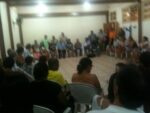
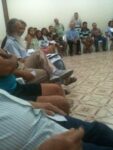
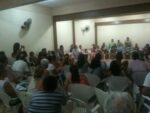
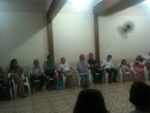
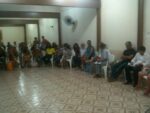
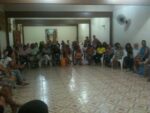
You must be logged in to post a comment.